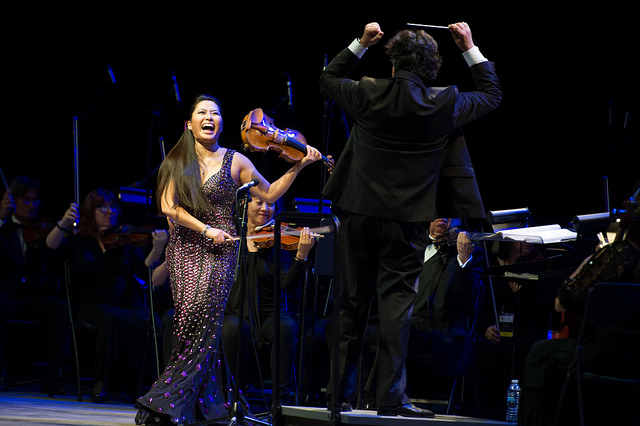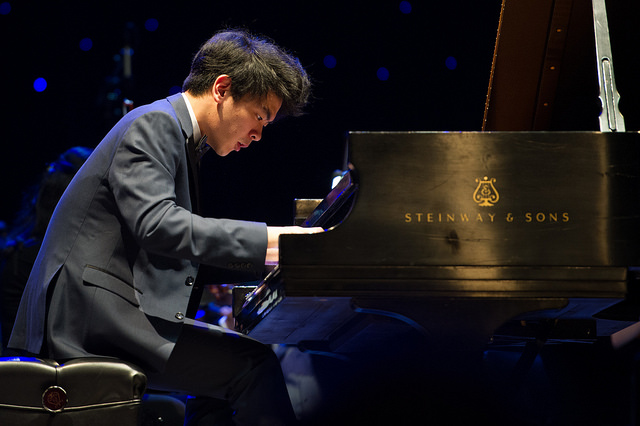
By Dennis D. Rooney
Presented as part of Festival of the Arts Boca, now in its 11th season, the March 10 concert featuring violinist Sarah Chang took place in an open-air structure at the north end of Mizner Park that was covered with a plastic tent.
I have never found the experience of hearing classical music outdoors to be enjoyable. Its textures and sonorities require a quiet enclosed space in which to develop. This event did nothing to alter that prejudice.
Even if the acoustics were better, it still would have been impossible as noisy traffic on U.S. 1 roared by, the bustle and overheard conversations of the passers-by at this self-styled “Lifestyle Center” (It reminded me more of Vanity Fair in Bunyan’s The Pilgrim’s Progress, or a very upscale midway at a state or county fair) that constantly intruded, the relentless whoosh of the high-velocity fans needed to circulate air into the tent, the smell of cheap white wine borne on the mechanically generated breeze, and the green glow of the illuminated Heineken sign over the beer stand situated in the far right corner of the space — in whole and in part, all militated strongly against the concentration needed for a proper hearing of what was on offer.
As I gazed at the musicians seated rather shallowly across the wide stage, in front of a scrim that apparently suggested to someone a starry night, my eyes were drawn to two loudspeaker banks hung on either side of the proscenium. Those would be necessary for the several announcements inevitable with this sort of event. However, when conductor Constantine Kitsopoulos mounted the podium to begin the concert, the first notes of Brahms’s Tragic Overture told me that the Symphonia Boca Raton, too, was amplified, and not lightly. Its collective sonority was clearly emanating from the speaker bank in front of me.
Furthermore, the highlighting of the various instrumental choirs was being mixed, quite inexpertly, according to the changing textures of the score. Double basses and cellos fared somewhat better than the orchestral violins and violas, but woodwinds were tightly microphoned, draining them of their true timbral quality and also unflatteringly emphasizing any weaknesses of tone production or intonation. The resulting account of the Brahms was dynamically flattened and electronically distorted. Through all of it, I could make out a pretty good ensemble that would have played more incisively with more rehearsal.

The piano set in front of the orchestra for Daniel Hsu’s performance of Tchaikovsky’s Piano Concerto No. 1 ( in B-flat minor, Op. 23) was electronically highlighted and the amplified piano sound completely obscured the natural sound of the instrument onstage. It was over-prominent in the mix and had a jangly, edgy character that was unvaryingly loud when it was not also distorted.
Three movements of that were not easy to endure, even if Hsu, a student of Gary Graffman at Philadelphia’s Curtis Institute, proved a more eloquent advocate for Tchaikovsky than he did. Instead, it was a workmanlike account, fitfully brilliant in its double octaves and passagework but occasionally untidy elsewhere, that underserved the composer’s lyric flights. Kitsopoulos did nothing to elevate the orchestral performance. Hsu seems to have the potential to mature into something more.
In the second of the two concertos on the program, violinist Sarah Chang also had a microphone in front of her for the Concerto No. 1 (in G minor, Op. 26) by Max Bruch. Now 36, Chang has been before the public since age eight and exemplifies poise and concentration. If she was playing her 1717 Guarneri del Gesù, it would have been hard to hear precisely, given the extraneous assault. Her sound was flattened by the amplification, which unfortunately accentuated her coup d’archet and other bow noises that audiences usually never hear, and her dynamics and tonal color were flattened.
Yet I was pleased that despite all the impediments to hearing her performance, her eloquence and intense communication finally overcame the myriad distractions, as befits a seasoned professional. The Allegro energico finale, famous for its double stops, was especially effective. The amplification seemed to recede, allowing more of the actual sound of her fiddle to be heard. It was gratifying to hear her triumph, and the audience was still applauding her as I was halfway back to my parking place.